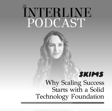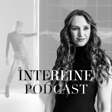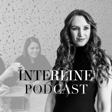Become a Creator today!Start creating today - Share your story with the world!
Start for free
00:00:00
00:00:01

Championing Change
As the apparel and footwear industries wrestle with the practicalities of turning discrete technology projects into broader transformation, we look at the mechanics of championing change through the lens of digital product creation.
For this episode, Ben is joined by Jared Goldman, VP of Design for footwear giants New Balance, and Sophia Lara, Digital Product Creation & Transformation Lead for Kalypso.
Artwork for this episode is courtesy of New Balance.
Transcript
Introduction to Digital Transformation
00:00:00
Speaker
really easy when things get difficult to fall back to the way you've always done something. So for us, I'll just give me my physical sample. I'll send something to Asia and I'll get it made and I'll wait my 45 days for it to come back.
00:00:15
Speaker
think differently and do a digital sample, make a decision using a digital sample and stick to it. Those are difficult to do and people that embrace that and move forward are the ones that are going to be ahead. All of us are going to be designing and creating assets for the Metaverse at some point. We need to have these digital capabilities on our teams. If you keep falling back,
00:00:43
Speaker
to the old way of doing something. At some point you're going to be left behind and you're just not going to have the ability to create assets for whatever the future holds. Well, we're here. Episode 3 of the Interline Podcast. Thanks for joining us.
00:01:00
Speaker
We're firmly into the spring of 2022 now, and that means the weather's getting warmer, but it also means we're officially more than two years into the pandemic. In some places, it means we're effectively past the pandemic from the point of view of everyday life coming back to normal, in-person events coming back in a big way. In other parts of the world, it's COVID still a vital and pressing problem.
00:01:23
Speaker
On a broader horizon, though, the fashion industry has largely figured out the technology deployments that were directly driven by the disruption of the last couple of years. And it's now staring down the question of what it means to knit together all those different discrete applications to create a single thread of digital transformation, one that's enabled by digital assets.
00:01:47
Speaker
And perhaps the best example of this shift in strategy is digital product creation, or DPC. A lot of brands and retailers have already successfully deployed 3D design and simulation to replace physical samples, or to bring concepts and prototypes to life and create a design.
00:02:05
Speaker
But a much smaller number have effectively turned those isolated sources of value into wider enterprise-level transformation. And from that point of view, this episode's a big one. We're going to spend the next 40 minutes or so shining a spotlight on the mechanics of how you turn short-term change into lasting transformation.
00:02:26
Speaker
With two headline guests, both of whom have approached this challenge from different but complementary angles.
Meet the Guests
00:02:32
Speaker
First, I'm joined by Jared Goldman, who is a VP of design for our giant New Balance. Jared and I did a deep dive on New Balance's digital product creation and material digitization strategy last year, so we're going to be picking up that conversation and we're going to be looking at what it means to champion digital change for one of the world's most recognisable brands.
00:02:50
Speaker
Second, and I'm going alphabetically here by surname, I'd like to welcome Sophia Lara, who leads digital product creation and transformation for Calypso, which is a practice that helps its clients discover, create, and make better products with digital. The Interline of Calypso collaborated on a ground-level study of DPC maturity around the turning point of 2020-21, which captured the fashion industry at an important digital juncture, so I'm keen to talk to her now to see what's changed since then.
00:03:21
Speaker
So, Jared, when we last spoke, it felt sort of like the pandemic was ending because that was last summer and we look back over how some big early moves in digital product creation had helped new balance to weather the worst disruptions of COVID. As it turned out, that way of thinking was maybe a bit premature. We've had another
00:03:43
Speaker
another rough winter since then at both society and industry levels, as well as seeing the emergence of a bunch of new opportunities. So I want to start us moving by getting your updated perspective on how New Balance's DPC strategy has evolved in the last year or so.
00:04:02
Speaker
Yeah, so you know, we continue with our digital strategy. And I think we were lucky that we started this, at least on a product creation side, I want to say about seven years ago. So when COVID hit, we were in a really good position where we can utilize digital assets. So, you know, we've used them, I guess I break it into kind of two different sections, product creation and sales and merchandising.
00:04:28
Speaker
On a product creation side, we've been utilizing these digital assets for us to make better decisions earlier in the process so we can get to that final solution. We're obviously trying to replace physical samples, just less samples, less cost, and then tie that into sustainability, less samples, less shipping, less materials, all of that. We're just continuing to evolve that.
00:04:56
Speaker
The other thing is the speed that we can go, where it takes us, let's say, five to seven days to make a really high-quality digital asset versus 30, 45, that time to make a physical sample and ship it or air freight it here is only increasing. That's on the product creation side and then more on the sales and merchandising side.
00:05:22
Speaker
Again, line planning with digital assets. We've sold off of digital assets during COVID because we didn't have physical assets. I still think there's a little bit of a comfort level that other teams, so sales, merchandising, even our retailers that you're relying just on a digital asset and not having that physical one.
00:05:43
Speaker
transition people need to make to fully go from physical to digital. But yeah, so again, we're really continuing to utilize what we started pre-pandemic and just expanding on that. And that's an interesting point there in that, if I'm reading you right, the
00:06:02
Speaker
Digital product creation, 3DS sets, they've almost been like a foil against some of the cost of goods rises and things, some of the complexities of actually getting hold of physical samples. I mean, even if we move beyond the acute pandemic phase where, as you said, you couldn't get physical samples, now you're in a stage where you can, but the cost of doing that has risen and that's making digital samples more attractive. Is that fair?
00:06:31
Speaker
Yeah, I think that the cost and the time to make and ship, right? Where we used to be able to make something and air freight here and get it rather quickly. The cost of air freight is, I don't know, I wouldn't double, triple, I don't even know what it is, but I know it's a massive amount now. And if you times that by hundreds of samples, that's a big cost. So yeah, I mean, it's only gonna make us,
00:07:00
Speaker
be able to move quicker if we can use these digital assets.
00:07:05
Speaker
Now, Sophia, I'd like to also ask the same question of you, but at more of an industry-wide level. Now, I know from spending a good amount of time with brands here in the UK before Christmas, this is Christmas 21, that DPC initiatives assumed a new importance during the pandemic, which is something Jared just underlined, when they became a lifeline for a lot of businesses.
00:07:31
Speaker
That's
Challenges in Digital Product Creation
00:07:32
Speaker
those same conversations of kind of clued us into the fact that that hasn't necessarily translated into enterprise wide change for everybody or even for a majority. So if I asked you to kind of benchmark the progress of digital product creation right now for the apparel and footwear industry as a whole, where would you set it?
00:07:51
Speaker
I would definitely say that digital product creation has become a standard way of working. I think that there's kind of two buckets that retail or businesses fall into. You have the people like New Balance who've been doing it for so long who are able with all the changes that happened because of the pandemic to really scale the foundation that they've been building for years. And then you have other companies that are newer to digital product creation that have utilized it
00:08:19
Speaker
Kind of as a bandaid in the moment but are now seeing all the benefits that you can take from kind of converting your business over to this digital so you know the sustainability the value that you bring back to your brand the earlier iteration and creation.
00:08:34
Speaker
I think one of the challenges that we see across the industry is those who have an adapted kind of a change management along with your digital product creation. Like it's a whole enterprise shift in the way that you're working, you're making decisions virtually, you're changing the way, you're changing the tools your designers are using, you're changing the data because now everything's trying to get connected. So those are kind of the challenges that we're seeing industry-wide of
00:09:01
Speaker
people or maybe even some functions that were like okay we'll do without the physical sample but now i really want it you know so.
00:09:10
Speaker
we find that the change management piece has become a huge need across enterprise to really make this a scalable shift from a whole way of thinking from the original of where it started. And I think that that's where the push is going to go as people try to scale and move from, oh, this was like a POC or a pilot. It's like, no, now how do we make this like part of our calendar? How do we implement the change across all the functions of the business?
00:09:39
Speaker
Okay, so I think we're all in agreement here. We all see that there's a huge amount of value in scaling digital part of creation beyond discrete applications and taking it to that enterprise-wide strategic change that Sophia just mentioned there. What do each of you see as being the major barriers to doing that for a hypothetical brand, for somebody who might be listening into this, who's in exactly that position?
00:10:07
Speaker
One of the areas that I find is when people look at digital product creation, sometimes they just focus on the technology. It's like the shiny object syndrome. They see things and it's great. You get excited about the possibilities with digital product creation, but they don't tie it back to a value and they don't change the original processes. It's like you want to go from Illustrator to this without really understanding that it's a whole mindset.
00:10:32
Speaker
I think that that's one of the areas that really helps at the very beginning when people are implementing this change to say, okay, this is how we're changing the ways that we're working, but really, what does this mean? What value are we capturing? How can we really affect the change and implement this? It's not just like, oh, this is a really cool product and it makes really pretty renderings. Okay, but how does that change? Is it going to help your photo studio? Is it going to help your designers or your marketing?
00:10:58
Speaker
more virtual assets so that we can do bigger marketing campaigns or what value are we bringing back to the business. I see that that's really the barrier of just the full thought process of affecting that change is the biggest thing that helps businesses effectively adopt the digital product creation and stay away from shiny object syndrome is what I tend to call it.
00:11:23
Speaker
Okay, perfect. Thanks, Sophia. Jared, from your point of view, either based on your own experience or as a hypothetical, what do you think would be the primary barriers to taking those discrete DPC applications and extending them? Yeah, I agree with what Sophia just said.
00:11:43
Speaker
Just to build on that, I always put together a three-year plan. What is our vision for our digital strategy for three years? Make sure that everybody understands what the vision is, why we're doing it, and how it's going to help them from whatever business part they're in.
00:12:01
Speaker
So that's really important. I typically will update that every year and that target might change. When we started in digital, the reason we were doing it was to get designers designing in 3D. Now, that vision is totally different seven years later. But I think you always have to keep checking what your vision is and then adjusting.
00:12:26
Speaker
The other two things that I think are really important is to have backing of your upper management. So I was lucky enough to have the people that I worked for believed in the vision that I had for digital assets and come along with that vision and that backing was a commitment to resources and a commitment to changing and how we work.
00:12:52
Speaker
And change is always a big one, right? We're trying to get people to do things differently than they've done in the past. So that's a big one. And then just having the resources. So if you want to scale, you have to have the digital artists that can help create these assets to move forward. You know, so for us,
00:13:14
Speaker
It's a combination of our designers, apparel and footwear designers, along with we have specific 3D visualization artists in the US and in Asia that are creating assets. But if you don't have a team to build all the assets, you can't scale.
00:13:31
Speaker
Jared,
Expanding the Use of Digital Assets
00:13:32
Speaker
I want to come back to you here because I know New Balance has gone way beyond design and development when it comes to extracting value from digital assets. The ones you just mentioned, the creation of those assets that's been scaled, extracting the value from them is now where things take a broader perspective.
00:13:50
Speaker
For anyone who hasn't read our previous collaboration, would you shine a light on just how far your strategy for those digital assets has extended and just how many areas of the business it now touches?
00:14:04
Speaker
Yeah, I can expand a little bit on what I was talking about before. So, you know, within product creation, our design teams, our marketing teams are using those assets. If you go to the kind of a brand marketing side, we're using those assets for some social media, some photography and just other marketing assets. We are continually creating content internally.
00:14:31
Speaker
and using these assets to explain our product. You know, it's always about storytelling. So as designers, you know, we want to be able to tell the story of why the shoe looks like it does. And we're able to use the 3D assets. We'll do exploded views, we'll do video rotations, that sort of thing to really
00:14:52
Speaker
Explain to our internal team what we're trying to the point we're trying to get across with the product So those are those are key ones, you know, I think we also stretched, you know last time we talked we talked about swatch book so we've been able we were able to implement swatch book as our
00:15:10
Speaker
material sourcing tool, and that's been a really, really strong tool for us, especially since we haven't been in the office. So all of our footwear vendors are on Swatchbook. They supply us materials digitally. Our designers are able to go into Swatchbook and
00:15:28
Speaker
find materials, look at all the different assets that are material properties, that sort of thing. So Swatchlist has been a great tool for us. Yeah, so I'd say those are the key points there. OK, great. And I mean, there's a strong example of the use of digital assets for both, like you said, changing the way you communicate and collaborate in-house, and also the way that you engage with your suppliers, right?
00:15:59
Speaker
Yeah, and I think our vision going forward is the digital asset almost becomes a tech package for us, where the footwear and apparel industry has been, I'd say a little bit old school, where we're using Illustrator and 2D tech packs and that sort of thing to communicate our ideas. And there's still a lot of interpretation that's left to somebody in a factory converting our 2D work into 3D work.
00:16:28
Speaker
And you know our vision for the future is that a designer starts maybe sketches in 2d but then they start to ideate in 3d and when we land on a finished 3d model 3d model goes over to our factory teams.
00:16:44
Speaker
They review it in 3D, look at it and say, is this manufacturable? Then comes back to us and we all confirm, hey, this is exactly what we want. It's a digital asset, we haven't made anything. Then the factory goes and makes that digital asset to match. That's really the goal of the future. From design to manufacturing, we're not there yet, but that's the goal where we want to get to.
00:17:10
Speaker
It's uncanny you said that because that's something we published an article about last week, as a matter of fact, is the potential to look at 3D assets as product definitions, as replacements for those 2D tech packs as a way of eliminating interpretation. I'll summarise by saying that's a vision we definitely endorse.
00:17:32
Speaker
It's funny, the challenge there has been that we can create an amazing digital asset. We can't always make the product to look as good as a digital asset because you can use all the tricks in asset creation to make something look just amazing. That's been the challenge is how to balance those two things.
00:17:57
Speaker
I would just say that in response to the asset creation, that's actually one of the barriers in my history when I was in the industry that we ran into in adopting DPC is some of the creative leads didn't want to work because they thought that the 3D asset looked too finalized and that they didn't have a say in the creative approach. So it's interesting to get them to come along to the journey. And I think that it's just so exciting to be able to kind of
00:18:22
Speaker
use these 3D assets now for so many different things beyond just a designer sketching. I'll come to you now, Sophia. How far does what Jared and his team are doing align with what you see as the largely untapped potential of DPC? Beyond some of those discrete applications that people are already familiar with, what else is out there? What is the real potential for a digital asset? I think
00:18:51
Speaker
building off of what Jared has said, it's just when you create in 3D, you're starting with an asset that already has all this data associated with it. So you're really not just designing, you're creating a whole virtual tech pack and beyond product creation. I mean, the possibilities are endless because you can take that and do consumer testing, you can take that and go to marketing. And because you have all this data attached to the beginning, it's just this, you have,
00:19:16
Speaker
people are building and businesses are building these integrated ecosystems where everything kind of connects and talks to it, which I think has never really been done before because before you had, you know, flat illustrator sketches or Photoshop that you needed to upload and somebody needed to manually add the metadata into it and then you needed to evolve from that. And so I think that now that we can kind of get all of that information at the very beginning from initial concept and start that process, I mean,
00:19:45
Speaker
There's so many areas that it can go that it's extremely exciting. I also think sometimes overwhelming because then everybody sees the possibilities and they want to do everything all up front. You have to build those roadmaps and make sure you're laying out the foundation because you want to make sure you're doing it correctly in the beginning so that you can leverage the information that you've added to your digital sample and take it all the way downstream.
00:20:09
Speaker
I think also, I'm sure that everyone's been talking about this, but the meta versus a huge conversation. Now,
Digital Assets in the Metaverse
00:20:16
Speaker
you can create digital assets that don't even need to be produced physically, they just live online. It's a whole another avenue for the consumer to get to know your brand, to get to understand your product. Beyond NFTs, you have your digital shop experiences. You can shop in the store with digital assets created. You have your mega world consumer who's just like,
00:20:38
Speaker
living online, they're shopping online, they have their online avatars, they have their online products, so like there's just so many areas of where you can take an initial concept of design and translate them throughout Beyond Product Development.
00:20:52
Speaker
I think it's quite telling the way you phrase that in that there's a bigger shift at play when you talk about metaverse digital assets, digital end products, in that it's a whole other business model for an industry that has gone
00:21:11
Speaker
centuries and being able to only sell physical goods, all of a sudden you have the ability, whether it's backed by NFTs or not, you have the ability to sell and engage consumers with digital goods. And that's a pretty fundamental and a pretty large scale shift that goes beyond just using digital assets to enhance the process of producing physical end products. Yeah, exactly. It could be like your whole marketing strategy on its own.
00:21:41
Speaker
It's very interesting and we see that you need to make sure you tie back to design so that everything has the stamp of the brand integrity and what it means for those products. But I think it's just a very exciting time because there's so many different possibilities that you could create.
00:21:58
Speaker
Jared, I think the footwear and apparel industry as a whole has a bit of a how do we get from here to there challenge on its hands at the moment. It's one that's very obviously apparent in how DVC initiatives have been ring-fenced, how they've been focused on replacing physical samples, for instance.
00:22:17
Speaker
It's also, it's equally applicable to other technology projects and pilots that have either achieved or mostly achieved their original aims, but then haven't gone any further. So for anyone that finds themself in that sort of situation where there's a technology pilot that's delivered on its original aims, has potential to go farther, but there is perhaps a technology component, a cultural component going that extra distance. What sort of advice would you give? You know, how did, how did New Balance go?
00:22:45
Speaker
about taking one success, replacing physical samples with digital ones, and turn it into so much more? Sure. Yeah. We're still on that journey. And we've done it in spots where we're able to replace that digital sample with physical. We're still working on how we scale that across the organization. But I think I touched on it earlier, having a three-year plan.
00:23:11
Speaker
But also having somebody who can champion that plan so you know this was something that i've been passionate about and we tried it and not succeeded and other companies and i think it was more about the technology wasn't ready.
00:23:28
Speaker
I'm but you know this this round that we've been doing it a new balance the technologies there we have the people that can create the assets and all of that has come together so it's something that i continue to push and i get support from my management team to be able to do that.
00:23:49
Speaker
So those are really two big things. And then obviously with that support comes a budget to build a team, add any technology that you need, that sort of thing. If you don't have that backing, it'll become really difficult to move your agenda forward.
00:24:11
Speaker
Sophia, looking through the same lens, using DPC as a bit of a template for other technology-driven transformations, what approach have you found has the greatest chance of turning discrete, isolated change into comprehensive, business-wide transformation? Because we've been talking deep digital work creation here, but that's emblematic of an overall need for
00:24:38
Speaker
Power brands, retailers and manufacturers to a similar extent to really start to not just scale and expand but accelerate their digital transformations.
00:24:52
Speaker
I think it's kind of a combination of everything that we've mentioned. I mean, again, when you are trying to implement a change, you definitely need that industry-level buy-in. Like Jared was talking about, you need an executive sponsor or champion who's really going to push for that change that's company-wide. And it's a combination of people, process, and tech, because technology really is just an enabler of a big change that you're trying to make.
00:25:20
Speaker
What do we really mean by technology? Are we trying to say that we're changing our processes? I think it's really understanding the business need that you're trying to affect, the value you're trying to capture, and then bringing everything together. Don't look at it in a vacuum. Make sure you understand.
00:25:37
Speaker
Because when you're making a huge shift like digital product creation or with any other technology or change that you're trying to make, like you mentioned before, it's a change in the way we make decisions. It's a virtual mindset. So you're changing the way, you're changing the skillset you're hiring for new hires.
00:25:52
Speaker
you're changing the way that you're training your teams, and you're changing their job description. So you have to really think about all of those levels of detail when you're trying to really have an effective implementation of a new way of working. Because
Integrating for Digital Success
00:26:06
Speaker
if you only think about the tech or you only think about the process, they really don't work together. You have to marry the people, process, and tech together to enable an enterprise level shift. Jared, there's another angle on this that I'd like to think about, which is,
00:26:22
Speaker
framing digital procreation as an example of
00:26:27
Speaker
kind of more comprehensive change or willingness to do things differently. And I know that's something that New Balance takes to heart is that willingness to challenge the status quo and to kind of run counter to expectations with things like domestic production. I'd be interested to see how that overall company mindset factored into your ability to really forge ahead with digitization to the extent that you have.
00:26:56
Speaker
I think it ties into our company values and what we stand for. We talk about being fearlessly independent and doing things our own way. The US factories are a great example. I think the athletes and the artists that we have that represent our brand are unique and not
00:27:20
Speaker
We're very selective to who we pick. I think that mentality probably rolls down to the way we do things within the organization and just our mindset. We're definitely a challenger brand and we have to do things differently than the big competitors because we're challenging them. I think in this space, it's the same thing. How do we use
00:27:47
Speaker
digital asset creation to be an advantage for us. Like I said, we've got started early on this. I feel like we're leading the way in terms of product creation.
00:28:04
Speaker
Just having that challenge or mentality when you're not scared to try something. We've taken it, we've tried, we've failed, we've made it better. So that's important in all of this. But yeah, I think that's just a mentality that's at new balance overall. And we find our own path, we figure out how we're gonna do it, and then we're able to build on that.
00:28:31
Speaker
It's great. And I think if there's a lesson for the industry as a whole to take from that, it's that willingness to reconsider the way things are done, to challenge expectations. And I think if you're a brand and you're looking at how to extend the value of digital assets, some of that is going to come from the willingness to ask questions about where they can be used, to ask questions about how things can be done differently once you have these building blocks.
00:29:00
Speaker
Yeah, you know, it's really easy when things get difficult to fall back to the way you've always done something. So for us, you know.
00:29:07
Speaker
I'll just give me my physical sample. I'll send something to Asia and I'll get it made and I'll wait my 45 days for it to come back. Think differently and do a digital sample. Make a decision using a digital sample and stick to it. Those are difficult to do. The people that embrace that and move forward are the ones that are going to be ahead. You touched on the metaverse earlier in this conversation.
00:29:35
Speaker
you know all of us are gonna be designing and creating assets for the metaverse at some point right so we need to have these digital capabilities on our teams so if you keep falling back to the old way of doing something at some point you're gonna be left behind and you're not just not gonna have the ability to create assets for for whatever the future holds.
00:29:58
Speaker
That's a great point. Thank you very much, Jared. Sophia, is there anything you want to add there in terms of having that kind of challenge your mindset and how that might be applicable to other brands in a similar position?
00:30:13
Speaker
It's really just about kind of coming back to making sure that when you're approaching this type of change, you really have your foundation in place because I think that when you make sure that you don't just skip to the end or, you know, try and do everything at once, it really will help you leverage your scalability so that you can get to all of those areas that digital product creation can take you and making sure that you have the right people in the room during those conversations will really enable the changes that you're trying to make.
00:30:41
Speaker
To bring this to a close, I want to ask both of you what you think the future holds for digital product creation and why you believe it's so important today for brands to be able to scale and sustain digital transformation. I think
The Future of Digital Product Creation
00:30:55
Speaker
that the future is just
00:30:59
Speaker
I think that the possibilities with digital product creation are endless. And I know that I said that a little bit earlier, but it brings a level of excitement because there's so many opportunities for where you could take this, you know, and it brings value in so many different ways. It brings value when you're creating product and you're reducing samples for sustainability, it brings value when you're able to design and iterate a lot without having to wait for that physical sample so that your designers have the flexibility to be more creative. And then you go into like the consumer facing side, you know, you can get these
00:31:28
Speaker
customized bespoke products that you can make without having to produce all of the physical material that behind it, you can create these moments for the consumer to go online and say, I want my own shoe, I want my own bag, I want this. I just think that there's so many different ways that you can utilize this to bring excitement to your own teams internally and also create excitement with your consumer when you're going out to the brand. Because you can take something that has
00:31:57
Speaker
not minimal effort because digital product creation is not a magic wand. They're very talented people who create these assets, who spend a lot of time and hours to make them look as amazing as they do look. But you can take that and really just reach so many different people. And especially with COVID, I think it's just shown how connected we can all be and how global everyone is. Now we're talking with people all over the world all the time, whereas before I don't think everyone was as like,
00:32:25
Speaker
Now we're probably Zoom exhausted, but it's one of those things that I think has opened the door to allow people to collaborate more and connect more as we just continue. I think digital is a must going forward. There's no brand that's not investing in this, and it's something that you have to have the capabilities in. We've talked a lot about the internal side of this from a product creation team to marketing and merchandising.
00:32:55
Speaker
There's also a huge side that goes along with the consumer. We've done a lot of consumer insights where we're sharing 3D assets and getting consumer feedback and then saying, okay, A, B, and C, we're the top rated ones, let's go make those colors or let's go make those models.
00:33:16
Speaker
There's just so many different directions you can go utilize digital assets that become a competitive business advantage. I think the companies that embraced the technology figure out how to scale it because scaling is a huge thing. For a company like New Balance, we create thousands of styles a year.
00:33:36
Speaker
Being able to create all of those styles digitally and make sure that they are perfect, right? A digital asset has to be perfect. It can't be kind of like it should look. It has to be perfect. You need to have a staff of people that can create those assets. So that's really important.
00:33:56
Speaker
yet we're going to continue to grow our digital asset team and creation ability and look at how to use them as we expand. Want to replace the physical assets to create NFTs or future things for the metaverse. There's so much in terms of digital and how you connect with consumers that it's just a must for any company going forward.
00:34:27
Speaker
That brings us
Conclusion and Future Outlook
00:34:28
Speaker
to the end of the show. Thanks for listening. You can find our collaborations with both New Balance and Calypso over at the Interline. And there's a lot more to come on both the mechanics of technology-driven change and, more specifically, the future of digital product creation throughout 2022. I hope you'll join me again next time.


















